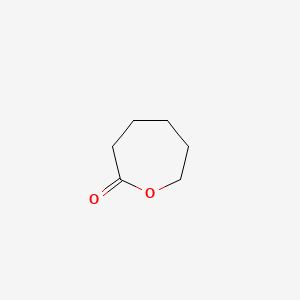



1. Epsilon-caprolactone
2. Epsilon-captolactamium Hydrogen Sulfate
1. Oxepan-2-one
2. Epsilon-caprolactone
3. 6-hexanolactone
4. 2-oxepanone
5. 502-44-3
6. Hexan-6-olide
7. Hexano-6-lactone
8. 6-hexanolide
9. E-caprolactone
10. 1-oxa-2-oxocycloheptane
11. 1,6-hexanolide
12. Epsilon-caprolactone Monomer
13. Placcel M
14. Polycaprolactone
15. 6-hydroxyhexanoic Acid Lactone
16. 2-oxacycloheptanone
17. 24980-41-4
18. Hexanoic Acid, Epsilon-lactone
19. .epsilon.-caprolactone
20. Hexamethylene Oxide, 2-oxo-
21. 6-caprolactone Monomer
22. 2-oxohexamethylene Oxide
23. 6-hydroxyhexanoic Acid, Epsilon-lactone
24. Chembl373123
25. Chebi:17915
26. 56re988l1r
27. Hexanoic Acid, 6-hydroxy-, .epsilon.-lactone
28. Epsilon-kaprolakton
29. Epsilon-kaprolakton [czech]
30. Hsdb 5670
31. 2-oxepanone, Homopolymer
32. Einecs 207-938-1
33. Brn 0106919
34. Unii-56re988l1r
35. 6-hexanalactone
36. Hexanoic Acid, 6-hydroxy-, Epsilon-lactone
37. Epsilon-hexalactone
38. Epsilon Caprolactone
39. Ece
40. Epsilon -caprolactone
41. .epsilon.-kaprolakton
42. Tone Eceq
43. Dsstox_cid_7159
44. Bmse000493
45. Caprolactone [hsdb]
46. Ec 207-938-1
47. Epsilon-caprolactone, 97%
48. Dsstox_rid_78329
49. Dsstox_gsid_27159
50. Schembl10850
51. 5-17-09-00034 (beilstein Handbook Reference)
52. Caprolactone, Epsilon-
53. .epsilon.-caprolactone Monomer
54. .epsilon.-hexanolactone
55. Dtxsid4027159
56. Hexanoic Acid, .epsilon.-lactone
57. Zinc388417
58. Epsilon-caprolactone [inci]
59. Oxepan-2-one; Epsilon-caprolactone
60. Hexanoic Acid, 6-hydroxy-, Lactone
61. Tox21_200445
62. Bbl011394
63. Bdbm50167993
64. C0059
65. Mfcd00003267
66. Mfcd00084404
67. Stl146497
68. Akos005721108
69. Cs-w016607
70. Polycaprolactonemn 70,000-90,000
71. Ncgc00248619-01
72. Ncgc00257999-01
73. Polycaprolactone (med Mw ~ 50.000)
74. As-14738
75. Cas-502-44-3
76. Db-051739
77. Ft-0625678
78. C01880
79. D70255
80. A828019
81. Q288104
82. Sr-01000944724
83. Sr-01000944724-1
84. W-109083
85. F0001-1311
| Molecular Weight | 114.14 g/mol |
|---|---|
| Molecular Formula | C6H10O2 |
| XLogP3 | 0 |
| Hydrogen Bond Donor Count | 0 |
| Hydrogen Bond Acceptor Count | 2 |
| Rotatable Bond Count | 0 |
| Exact Mass | 114.068079557 g/mol |
| Monoisotopic Mass | 114.068079557 g/mol |
| Topological Polar Surface Area | 26.3 Ų |
| Heavy Atom Count | 8 |
| Formal Charge | 0 |
| Complexity | 88.5 |
| Isotope Atom Count | 0 |
| Defined Atom Stereocenter Count | 0 |
| Undefined Atom Stereocenter Count | 0 |
| Defined Bond Stereocenter Count | 0 |
| Undefined Bond Stereocenter Count | 0 |
| Covalently Bonded Unit Count | 1 |
The incorporation of estramustine into biodegradable waxy type copolyesters, prepared by direct copolycondensation of epsilon-caprolactone and delta-valerolactone in the absence of catalysts, to apply as implantable matrices for drug delivery systems, is described and the in vivo capability of the implantable device was evaluated by implanting into the back of male rats. The copolyesters are much more subject to erosion than their homopolyesters, in which the degradation is further accelerated by the action of lipase type enzyme. The drug release, although accompanying a burst phenomenon in the initial stage, was kept constant throughout an experimental period of 19 wk from the first to twentieth wk. In this case, the release pattern was parallel to the degradation pattern, in support of the release being the rate-limiting step in the degradation of the polymer. The results showed about 75% of the initial drug content was still present in the device even after 20 wk of implantation. This finding means that the biodegradable poly(epsilon-caprolactone-co-delta-valerolactone) wax is useful as an implantable matrix for a drug delivery system which controls the release over a relatively long period of time. The in vivo activity of the drug was demonstrated by observing atrophy of the seminal vesicles and ventral prostate in male rats 10 wk after implantation.
Imasaka K et al; Int J Pharm 68 (Feb 1) 87-95 (1991)
The release of levonorgestrel from a poly(epsilon-caprolactone) capsule implanted subdermally in 8 women was studied over 5 menstrual cycles. All subjects except one experienced suppression of ovulation while the capsule was in place (one cycle). The capsules contained 16 mg of drug and 61 mg of ethyl oleate as a suspending vehicle. There was a wide range of serum levels of the drug. Suppression of ovulation appeared to occur at a serum level of 300 pg/ml or greater.
PMID:6402933 Ory SJ et al; Am J Obstet Gynecol 145 (Mar 1): 600-5 (1983)
CAPROLACTONE INHIBITED PROTEOLYTIC & FIBRINOLYTIC ACTIVITIES OF HUMAN PLASMIN. IN VERY LOW CONCN, IT ALSO INHIBITED ACTIVATION OF PLASMINOGEN THROUGH PLASMIN-STREPTOKINASE ACTIVATOR & HUMAN UROKINASE.
PMID:4225897 AUERSWALD W, DOLESCHEL W; SCIENCE 156 (3779): 1244 (1967)